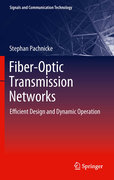
Fiber-optic transmission networks: efficient design and dynamic operation
Pachnicke, Stephan
Next generation optical communication systems will have to transport a significantly increased data volume at a reduced cost per transmitted bit. To achieve these ambitious goals optimum design is crucial in combination with dynamic adaptation to actual traffic demands and improved energy efficiency. In the first part of the book the author elaborates on the design of optical transmission systems. Several methods for efficient numerical simulation are presented ranging from meta-model based optimization to parallelization techniques for solving the nonlinear Schrödinger equation. Furthermore, fast analytical and semi-analytical models are described to estimate the various degradation effects occurring on the transmission line. In the second part of the book operationalaspects of optical networks are investigated. Physical layer impairment-awarerouting and regenerator placement are studied. Finally, it is analyzed how the energy efficiency of a multi-layer optical core network can be increased by dynamic adaptation to traffic patterns changing in the course of the day. Gives in-depth information on design and simulation of fiber optic transmission systems. Discusses possible improvements to reduce the simulation time. Connects both fields of networking and design & simulation INDICE: Introduction. Fiber Optical Transmission Systems. Simulation of Fiber Optical Transmission Systems. Efficient Design of Fiber Optical Transmission Systems. Dynamic Operation of Fiber Optical Transmission Networks. Conclusions and Outlook. Appendix.
- ISBN: 978-3-642-21054-9
- Editorial: Springer Berlin Heidelberg
- Encuadernacion: Cartoné
- Páginas: 163
- Fecha Publicación: 31/10/2011
- Nº Volúmenes: 1
- Idioma: Inglés
